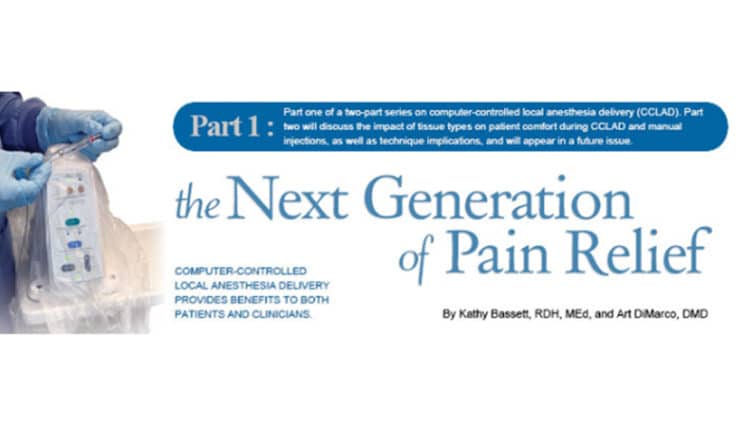
The Next Generation of Pain Relief
Computer-controlled local anesthesia delivery provides benefits to both patients and clinicians.
Dental hygienists play an important role in managing patient comfort, and the administration of local anesthesia is a key strategy in ensuring a positive dental experience for patients. Advances in local anesthesia delivery, such as the introduction of computer-controlled local anesthesia delivery (CCLAD), have made the administration of pain relief easier.
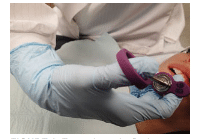
Pain management is key not only for patients, but clinicians as well. Incorporating the principles of ergonomics into practice is integral to the safe delivery of dental hygiene services. Risk factors for musculoskeletal injuries and pain include awkward and/or static hand posture, the use of applied force, and repetitive movements. Traditional methods of injecting local anesthetics with manual syringes can involve all of these risk factors.
Equipment limitations can also impact patient comfort during injections. Syringe and needle selections affect rates of delivery (flow rates) and fluid pressures generated during delivery, in addition to forces of aspiration (thumb flexion).1,2 The use of CCLAD delivery may decrease these risk factors and improve both operator and patient comfort.
The Wand STA Single Tooth Anesthesia System® Instrument is the only CCLAD system currently marketed in the United States. The system offers ergonomic benefits to clinicians, while also helping to improve injection fluid dynamics and needle positioning and penetration for periodontal ligament (PDL) injections. Two additional CCLAD systems—the Comfort Control Syringe® and Compudent—are no longer being manufactured, but accessories to support both systems remain available.

ERGONOMIC BENEFITS
Awkward hand and wrist positions are common during local anesthesia administration, especially when reaching across patients to achieve proper angles for injections that are oriented toward the clinician (Figure 1). These deviations compound loss of strength and control and contribute to cumulative trauma and work-related musculoskeletal disorders.1,3 The adaptation of poor wrist postures and flexion and extension of the palm and thumb (Figure 2 and Figure 3), which are common during aspiration tests with manual syringes, may also contribute to musculoskeletal injury.1
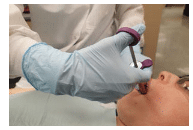
The use of manual syringes requires muscle activity and forces applied by the thumb, with the highest force applied during flexion while performing aspiration tests.1 In Figure 4, the clinician with the larger hand (top) maintains a relaxed hand posture with moderate thumb flexion, while the clinician with the smaller hand has to hyperextend the muscles of the palm with thumb flexion to accomplish the same degree of aspiration. Figure 3 demonstrates the thumb flexion required to aspirate with a manual syringe during an inferior alveolar nerve block while Figure 5 illustrates the hand postures for the same injection with a CCLAD device during aspiration. For clinicians with small hands (those who use extra-small- or small-sized gloves), a CCLAD device can provide an ergonomic advantage during local anesthetic administration.
INJECTION FLUID DYNAMICS
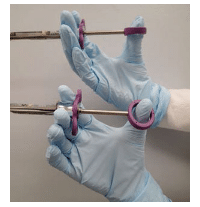
Fluid pressures are created when plungers are depressed to create a flow of anesthetic into the tissue.2,4,5 Most patients experience discomfort when needles penetrate the oral mucosa. Pain may also be perceived from pressures generated at needle tips when anesthetic solutions are injected submucosally.2,5
Standard injection protocols recommend slow deposition of drugs because solutions will become diluted in the event of an inadvertent intravascular injection, thus slowing any toxic effects. Discomfort from the pressure of the solution moving through the needle is also minimized.2,4 During the first few seconds of an injection, a burst of fluid may be expressed at the needle tip, likely due to the force required to mobilize the plunger at the beginning of the injection.5 This rush of fluid and the subsequent pressure of the drug being expelled from the needle tip are described as injection fluid dynamics. The goal is to have drops of anesthetic solution drip from a needle tip, as opposed to a continuous, sustained flow that shoots out.5 When drops exit a needle bevel, very little pressure is exerted on surrounding tissues, but bursts can generate interstitial pressures that exceed pain thresholds.5 Controlling injection fluid dynamics is challenging when manual syringes are used.2,5
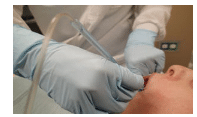
The frequency and pressure of bursts can be influenced by a clinician’s level of experience and gender, as well as the gauge of needles. In a comparison study that included practicing dental and dental hygiene clinicians and students, bursts were generated in the first 3 seconds in two-thirds of simulated depositions.5 Overall, experienced clinicians generated more bursts compared to student clinicians, and men created more bursts than women. The students’ reduced number of bursts was attributed to their increased level of caution when performing the injections.2,4
The CCLAD device administers anesthetics drop by drop during the initial stage of the injection, with a slow consistent increase in the injection rate over time. The technology monitors and regulates real-time pressures generated at the needle tip. Fluid dynamic pressures are continuously measured and limited to preset values. At the PDL setting, the flow rate remains at the slow drop-by-drop rate to minimize fluid pressures.
During an injection, the neuromuscular skeletal system is stimulated when pressures from tissue resistance increase and clinicians instinctively exert more force on plungers of manual syringes.5 Studies suggest that the pressure threshold for triggering pain is approximately 6 pounds per square inch.4,5 A CCLAD device controls both flow rates and fluid pressures, thus eliminating the inconsistency caused by differences in technique when clinicians use manual syringes.4,5
NEEDLE POSITIONING AND PENETRATION

Proper positioning of needles and adequate aspiration to avoid injecting into blood vessels are critical components of most injections. Gender and hand size differences can compromise ease of aspiration and deposition with manual syringes.5,6 Additionally, the calibrated electronic operations of CCLAD systems improve control, consistency, and safety during aspirations.
With manual syringes, repeated needle insertions are necessary to deliver more than 1.8 mL of anesthetic at a single site. Each needle penetration creates some degree of tissue trauma and poses a risk for vascular injury. Additionally, aspiration tests with manual syringes require significant pressure on the thumb joints of clinicians, and injections into high-density tissues require significant hand pressures to express anesthetic solutions from syringes.2,7 When using the Wand system, the needle does not need to be withdrawn to deliver an additional cartridge of anesthetic. The needle tip can be maintained at the deposition site while an assistant loads the additional cartridges into the CCLAD base and delivery is continued (Figure 6). Aspiration is then accomplished by activating the foot pedal. One needle insertion is completed and no pressure is generated on thumb joints or hands during any aspect of the injection.
CONCLUSION
Strategies that promote comfort help to reduce stress for both patients and clinicians. The use of CCLAD to reduce injection pressures and pain for patients can have additional ergonomic benefits for clinicians. With its lightweight plastic handpiece, its maneuverability due to its much smaller size compared with manual syringes, and its controlled flow rates, the CCLAD device reduces stress on hands and body while maintaining safety and efficacy for all injection techniques.
REFERENCES
- Kaufman KR, An KN, Litchy WJ, Cooney WP 3rd, Chao EY. In vivo function of the thumb muscles. Clin Biomech. 1999;14:141–150.
- Kudo M. Initial injection pressure for dental local anesthesia: effects on pain and anxiety. Anesth Prog. 2005;52:95–101.
- American Journal of Advanced Drug Delivery. The Wand: A Mini Review of an Advanced Technique for Local Anesthesia Delivery in Dentistry. Available at: ajadd.co.uk/PA-AJADD-NDD-2014-005-[1].pdf. Accessed June 18, 2014.
- Hochman MN, Friedman MJ, Williams W, Hochman CB. Interstitial tissue pressure associated with dental injections: a clinical study. Quintessence Int. 2006;37:469–476.
- Tzafalia M, Sixou JL. Administration of anesthetics using metal syringes. An ex vivo study, Anesthesia Prog. 2011;58:61–65.
- Wiener RC, Crout RJ, Sandell J, et al. Local anesthetic syringe ergonomics and student preferences. J Dent Educ. 2009;73:518–522.
- Bassett KB, DiMarco AC, Naughton DK. Local Anesthesia for Dental Professionals. 2nd ed. Upper Saddle River, New Jersey: Pearson Prentice Hall; 2015.
From Dimensions of Dental Hygiene. July 2014;12(7):36-38.

